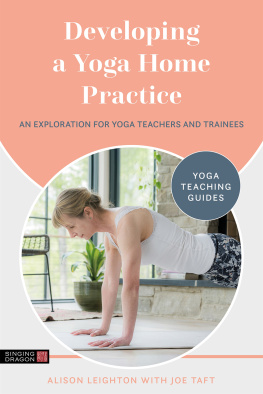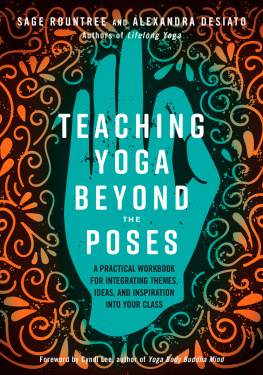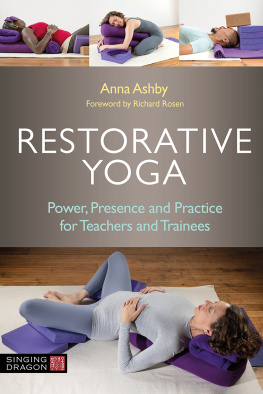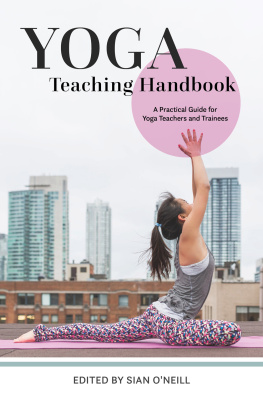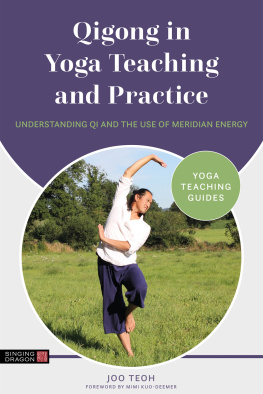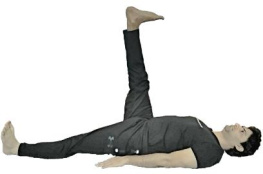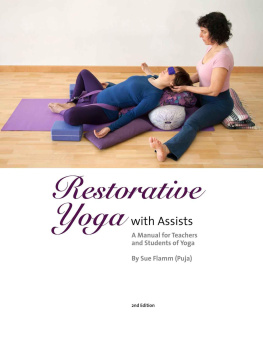Contents
Page list

Yoga Teaching Guides
As it grows in popularity, teaching yoga requires an increasing set of skills and understanding, in terms of both yoga practice and knowledge. This series of books guides you towards becoming an accomplished, trusted yoga teacher by refining your teaching skills and methods. The series, written by experts in the field, focuses on the key topics for yoga teachersincluding sequencing, language in class, anatomy and running a successful and thriving yoga businessand presents practical information in an accessible manner and format for all levels. Each book is filled with visual aids to enhance the reading experience and includes top tips to highlight and emphasize key ideas and advice.
in the same series
Qigong in Yoga Teaching and Practice
Understanding Qi and the Use of Meridian Energy
Joo Teoh
Foreword by Mimi Kuo-Deemer
ISBN 978 1 78775 652 6
eISBN 978 1 78775 653 3
Yoga Teaching Guides
Supporting Yoga Students with Common Injuries and Conditions
A Handbook for Teachers and Trainees
Dr. Andrew McGonigle
ISBN 978 1 78775 469 0
eISBN 978 1 78775 470 6
Yoga Teaching Guides
of related interest
Yoga Teaching Handbook
A Practical Guide for Yoga Teachers and Trainees
Edited by Sian ONeill
ISBN 978 1 84819 355 0
eISBN 978 0 85701 313 2
Yoga Student Handbook
Develop Your Knowledge of Yoga Principles and Practice
Edited by Sian ONeill
Foreword by Lizzie Lasater
ISBN 978 0 85701 386 6
eISBN 978 0 85701 388 0
DEVELOPING A
YOGA HOME
PRACTICE
An Exploration for Yoga Teachers and Trainees
Alison Leighton with Joe Taft
Series Editor: Sian ONeill

First published in Great Britain in 2022 by Singing Dragon, an imprint of Jessica Kingsley Publishers
An Hachette Company
Copyright Alison Leighton and Joe Taft 2022
The right of Alison Leighton and Joe Taft to be identified as the Authors of the Work has been asserted by them in accordance with the Copyright, Designs and Patents Act 1988.
Photographs copyright Jesse Kitt Photography 2022
All rights reserved. No part of this publication may be reproduced, stored in a retrieval system, or transmitted, in any form or by any means without the prior written permission of the publisher, nor be otherwise circulated in any form of binding or cover other than that in which it is published and without a similar condition being imposed on the subsequent purchaser.
A CIP catalogue record for this title is available from the British Library and the Library of Congress
ISBN 978 1 78775 704 2
eISBN 978 1 78775 705 9
Jessica Kingsley Publishers policy is to use papers that are natural, renewable and recyclable products and made from wood grown in sustainable forests. The logging and manufacturing processes are expected to conform to the environmental regulations of the country of origin.
Jessica Kingsley Publishers
Carmelite House
50 Victoria Embankment
London EC4Y 0DZ
www.singingdragon.com
CONTENTS
Chapter 1
BEFORE YOU BEGIN
Why a home practice is important
The idea for this book came about as a result of things I wish I had known whilst developing my home practice as a trainee yoga teacher and, once qualified, as a new yoga teacher. During my training, we were very much encouraged to have a home practice, to explore how poses felt in our bodies and to fully understand correct alignment in syllabus poses. However, there was much to learn on the course, and homework to do, making it a challenge to find time to place a significant focus on my home practice beyond the necessities of the course. Perhaps I wasnt present enough. As Thich Nhat Hanh says: If you love someone, the greatest gift you can give them is your presence.
On reflection, I could have been more present in my home practice, as it would have been a gift to myself. Practicing at home felt like a means to an end rather than being a wholly enjoyable experience. My focus was mainly on learning the alignment of poses. Later, when I started teaching, much of my home practice was taken up with designing sequences to teach rather than being a way to enrich my own yoga practice. I was attending yoga classes to do that.
I wish I had known how to use and develop my home practice as a means to experiment and develop my own personal yoga experience. In later years, when I was practicing solely for myself, I realized that a number of things were beginning to change. First, I felt that my practice really began to deepen. I was able to practice with a greater degree of presence and offer that presence to loved ones in my life. My breathing became more even; it was easier to access the breath in my practice. My strength and flexibility improved. Most of all, I felt that my home practice really informed my teaching. The more I practiced at home for myself, the better my classes became, and my class numbers increased. It felt very empowering.
Being a yoga teacher requires continuing study and practice. Having a home practice is an essential form of self-study that, if you are open to it, reveals teachings about your body, attitudes towards your practice and the connection between your mind, body and breath. Perhaps you can also include a spiritual practice in this list if you have one, or you might find a spiritual practice evolves. A home practice is much more than a tool to improve your physical asana practice. A home practice can become an integral part of your day and it can bring practices learned on your mat out into your daily life.
Perhaps you have fallen out of the habit of having a home practice but want to return to it. Maybe you feel stuck in your practice, with it lacking variety, or you already have a good home practice and want to build on it. This book aims to inspire you to develop a home practice that is nourishing, experiential and a place from which your own style of yoga can evolve. It is not a guide to alignment of poses; there are many resources that can help with that. Instead, the book aims to complement what you have learned on teacher training courses and provide you with a different perspective on having a home practice.
How to use the book
You should regard each chapter in this book as a layer in the development of your home practice. Each chapter or layer builds on the previous one. The book begins by exploring the gift of presence and then goes on to review basic concepts in , which are then developed, exploring the magic of the breath, breath-inspired movement, the power of intention, energetics and connecting with your creativity to find new shapes and transitions. Basic concepts in your home practice are expanded into a journey of exploration. The aim is to spark curiosity and creativity and to make your practice an immersive and rewarding experience.
It is also possible to use the book in a flexible way, so if you prefer to dip into specific chapters then you will be able to do this without having worked through some of the previous chapters.
Use the book over time. Dip into the book, leave it and then come back to it again. Dont rush the development of your home practice; let it simmer and evolve.
What is a home practice and what is needed?
A home practice is when you practice alone at home or in another space, without being led by another, and create your own practice. It may be a practice of focusing on the breath or a mediation and/or a physical practice of asana. The point of a home practice is that it is your creation and exploration.

